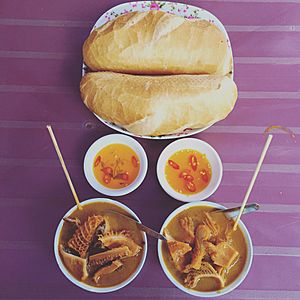Phá lấu facts for kids

Phá lấu as served in Vietnam
|
|
| Place of origin | Vietnam |
|---|---|
| Main ingredients |
|
| Similar dishes | sekba, kway chap, Burmese pork offal skewers |
Phá lấu is a yummy and unique dish from Vietnam, especially popular in Ho Chi Minh City. It's a kind of stew made with different parts of pork, like the liver, intestines, or stomach, which are called "offal." These parts are cooked slowly in a special broth filled with amazing spices.
Contents
What is Phá lấu?
Phá lấu is a traditional Vietnamese stew. It uses pork offal, which means the internal organs of the pig. Don't worry, it's very clean and cooked until it's super tender! The dish gets its rich flavor from a special mix of spices.
The Special Spices
The main spice mix used in Phá lấu is called five-spice powder. This powder usually includes cinnamon, cloves, fennel seeds, star anise, and Sichuan peppercorns. Sometimes, curry powder is also added to give it an extra kick. These spices make the broth very fragrant and tasty.
How Phá lấu is Cooked
The pork offal is first cleaned very well. Then, it's slowly braised, or simmered, in the spiced broth. This slow cooking makes the meat incredibly soft and full of flavor. The broth becomes rich and savory from the meat and spices.
How to Enjoy Phá lấu
When Phá lấu is served, you often get small wooden sticks. You use these sticks to pick up pieces of the tender meat. Then, you dip the meat into a special sauce. This sauce is usually made with fish sauce, lime or kumquat juice, pepper, and chili. It adds a tangy and spicy kick!
Phá lấu can be eaten in different ways. You can have it with plain rice, or with noodles. Another popular way is to eat it with bánh mì, which is a type of Vietnamese baguette. The bread is perfect for soaking up all the delicious broth.
Phá lấu Around the World
This tasty dish is most famous in Ho Chi Minh City, Vietnam. But you can also find similar dishes in other places. In Cambodia, for example, a dish very much like Phá lấu is called pak lov (Khmer: ផាក់ឡូវ). It shows how food traditions can be shared and enjoyed across different countries!

